It's March, which means it's time for this year's batch of TVs to start making its way to stores and customers' homes. And one of the most anticipated new TVs this year is LG's new W7 series OLED TV, the 65-inch OLED65W7P. We got a chance to test out the new flagship set earlier this week at a press event in San Francisco and to say we were impressed with what we saw would be an understatement.
You Can Never Be Too Rich or Too Thin
LG's so-called "wallpaper TV" measures up at just 3.81 mm thick (0.15 inches), or about the width of three stacked US quarters. How did they make it so thin? LG took the source switching, power supply, video processors and speakers out of the display and put them into a separate sound bar. The only cable you need to connect the W7 TV to the soundbar is a thin white ribbon cable (supplied) that can be surface-mounted on your wall and painted or hidden in a channel so it's virtually invisible. Oddly, the cable is not rated for in-wall use, but a professional installer can probably come up with a clever solution to make it invisible (one that meets your local code, of course). The ribbon cable is fairly short but an extension cable can lengthen it to 81 inches.
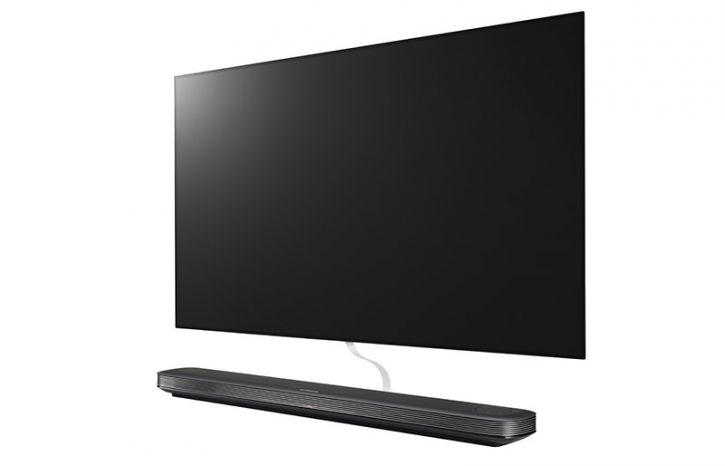
To allow the TV to really hug the wall, LG created a superslim steel bracket with powerful magnets that hold the TV snugly against the wall. At just 18 pounds, the TV doesn't need much to hold it up so it appears the slim steel/magnetic mounting system is more than up to the task. Tugging on the edges of the TV did cause it to peel back a bit from the wall a bit in the corner, but it would take significant effort to actually bring the TV down once it's mounted.
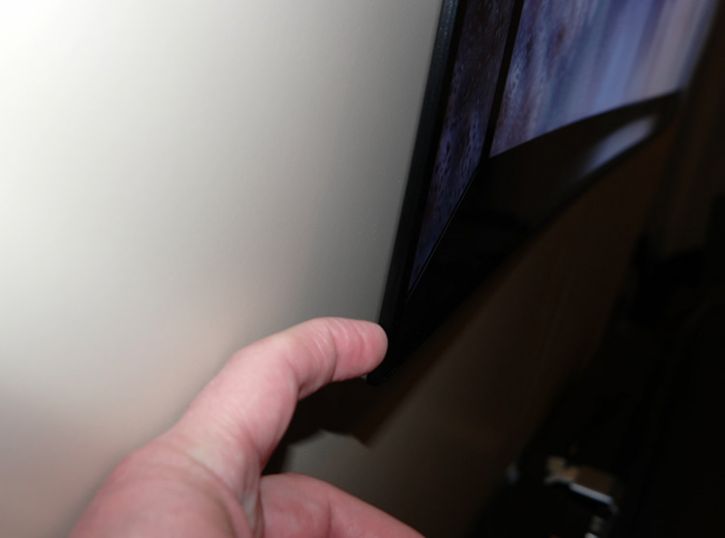
And while the TV's design is certainly impressive, it's the picture quality that is going to get people excited. With their self-emissive pixels, OLED (Organic Light Emitting Diode) TVs have always been good at generating deep inky black levels that give the image almost three dimensional image quality. But this year, LG has tweaked a few things in order to squeeze even higher performance out of the new sets.
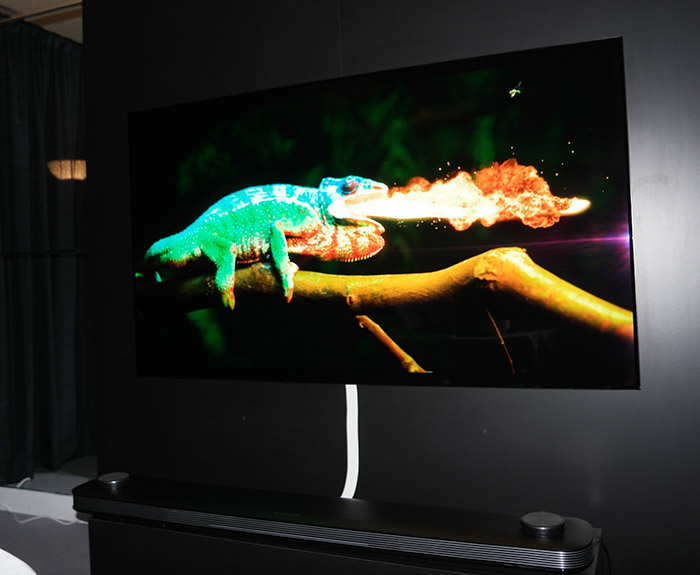
LG has boosted the peak brightness (luminance) about 25% over last year's models. This improves perceived contrast and makes movies, sports, TV shows and other content look even more lifelike and dynamic. In our preliminary tests we saw luminance peaks of around 750 nits in a 10% white window, but the set is likely capable of even higher peaks in real world content. LG claims a peak luminance of up to 1,000 nits in a 3% white window in HDR mode.
LG has also improved color accuracy, eliminating a slight tendency toward teal in the blues. Skin tones look particularly lifelike this year. And for those who like the dark, you'll be happy to hear the company has improved shadow detail on their panels while also significantly reducing noise in dark areas of the image. Other improvements include an improved game mode with lag of just 20 millisesconds and an enhanced filter on the screen that eliminates the red tinge that some folks noticed on last year's models. It also minimizes screen glare and reflections from ambient room lights. Fans of 3D will be disappointed however, as 3D is no longer an option on LG OLED TVs this year.
Robert Heron of Heron Fidelity and I spent some quality time with the W7 this week, running it through a diverse range of test patterns and measurements to gauge color accuracy, grey scale tracking, video processing, brightness, contrast and more. Grey scale tracking and color accuracy were excellent out of the box and superb after calibration. Tweaking the grey scale tracking became easier this year, courtesy of a two point grey scale adjustment (high and low adjustments for red, green and blue). After measurement and calibration, we played some of our favorite Ultra HD and HD Blu-rays to see how the set fared on real-world content.
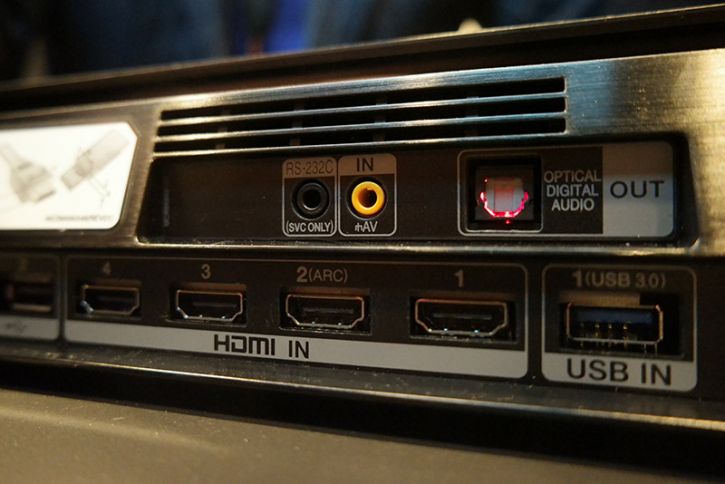
"Harry Potter and the Deathly Hallows, Part II" is a fairly dark film, both figuratively and literally. When the death eaters are ready to move against Hogwarts, hundreds of evil magicians take their positions on a dark hillside. On a lesser TV, the cloaked wizards would blend invisibly into the background, but on the W7, you can easily make out these villains. As their spells descend upon the protective shield around the school, bolts of bright electricity light up the night contrasted against a foreboding black sky. This film is not yet available on Ultra HD Blu-ray (that's coming soon) but the 1080p Blu-ray disc version looked pristine and detailed on the W7 with nice shadow detail.
Moving over to High Dynamic Range (HDR)-enabled content, the W7 showed incredible detail resolution and color saturation, even on challenging material such as the mottled scaly body of a chameleon, or the flames shooting out of said chameleon's mouth. Clips encoded in Dolby Vision HDR were the most impressive, with rich, deeply saturated reds, greens, blues, purples and oranges... and those deep inky blacks. Reproduction of black - as in the complete absense of light - is definitely the OLED's not-so-secret weapon. Because each OLED pixel can be turned on or off at will, the W7 does an excellent job reproducing difficult content such as starfields and crisp white credits scrolling on a pitch black background. Even the best full array backlight LED/LCD TVs have some degree of blooming or light bleed with this type of material.
In addition to Dolby Vision, the W7 also supports the HDR 10 standard, which is what we currently find on many Ultra HD Blu-ray Discs. We popped in some of our favorites like "Deadpool," "Mad Max: Fury Road" and "Star Trek: Beyond." The W7 presented a cinematic viewing experience with a bright, colorful image that virtually popped off the screen, with excellent contrast and color reproduction. While there were some minor motion artifacts and some slightly jagged edges on diagonal images (really only visible at closer-than-normal viewing distances), the W7 reproduced moving images perhaps the best I've ever seen on a display device.
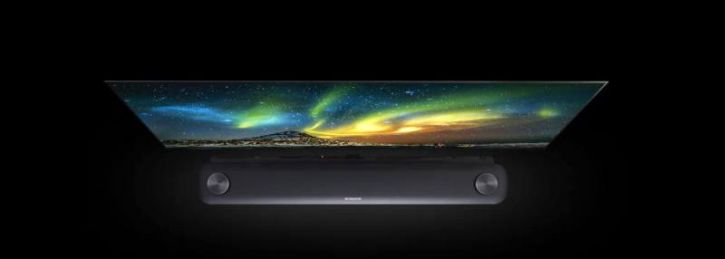
Big Sound?
We've spent a fair amount of words on describing the W7's image quality, and for good reason: it's truly outstanding. But LG's efforts don't stop with that Big Picture. The W7 also includes a beefy soundbar, powered by Dolby Atmos technology. The W7 is one of the first TV sets which supports Dolby Atmos surround sound, both with the included soundbar and with external gear (like receivers or preamp/processors) via HDMI passthrough. How does it do that, you might ask? The W7's soundbar incorporates brand new sound virtualization technology from Dolby. With sound virtualization, you can fool the brain of listeners to think that sound is coming from somewhere that it's not. At least in theory. A big part of Dolby Atmos experience is the ability to create sound from all around the listener: not just to the sides and rear of the viewers, but above them as well. Using what Dolby has learned about psychoacoustics and sound properties over the years, the LG soundbar attempts to create a "virtually immersive" soundfield without the use of surround speakers or height speakers? So... does it work? Well, sort of.
We listened to a fair amount of Dolby Atmos content on the W7's sound bar. Dialog was clear, and music and sound effects were well articulated. And the soundfield did sound much larger than the physical form of the soundbar. But I never really got the illusion that sound was coming from behind me or above me. While the W7 soundbar does have two upward-firing speaker drivers (which emerge dramatically from the soundbar on power up), these are not the traditional Atmos height modules that are designed to bounce height channel sound off the ceiling. LG calls the soundbar a "4.2.0" system, so it has four directional channels, two woofers, and zero dedicated height channels.
According to LG reps, the upward firing drivers are used to help make it sound like the dialog and music is coming from the screen, instead of from the soundbar, which could be well below the screen. And to this extent, the soundbar design is pretty successful. And I will say that Dolby Atmos content on the W7 soundbar does sound more engaging and immersive than regular stereo sound or surround sound, but it's really a pale shadow of what can be done with a real Dolby Atmos sound system with discrete ceiling speakers.
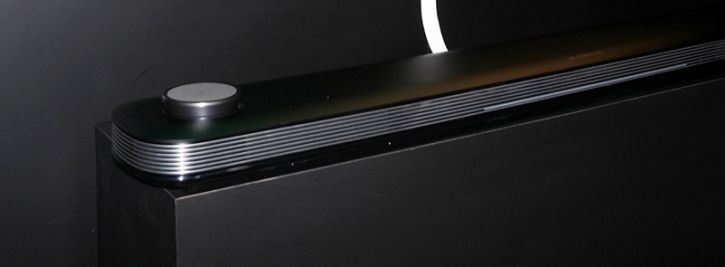
Also, the soundbar's volume never really reaches impressively loud levels, even at 100% volume. Is it better than the speakers built into most TVs? Absolutely. Will it satisfy an audiophile who really digs 3D immersive surround sound? Probably not. The good news is that LG and Dolby reps assured us that the W7 (as well as other models in the 2017 LG OLED line-up) will be able to pass through Dolby Atmos sound (via Dolby Digital Plus) using the set's HDMI ARC (Audio Return Channel) capability. If true, this would be the first set we've ever seen that can do that. Unfortunately we didn't have the right gear at the event this week to test this, but I do look forward to testing it back at the BPBS labs in the near future.
"If You Have To Ask..."
The W7 is a state of the art flagship display. As such, it's not cheap: $7,999 in the 65-inch size. A 77-inch version is expected to ship later this year, though pricing and dates were not available for that model. But one piece of very good news is that the same exact OLED panel and audio/video processor will be available through the entire 2017 lineup: B Series, C Series, E Series and G series. Though the styling will be somewhat different, and some setup options may differ, all of the models in LG's 2017 OLED line-up will support Dolby Vision HDR, HDR 10 and the upcoming Hybrid Log Gamma (HLG) HDR formats. Also, all models will support Dolby Atmos passthrough. And they should all behave in the same ways when it comes to user interface, video processing and image quality. So if you're hankering for some OLED picture quality, but can't quite spring $8K for a TV, there is hope for you in the form of LG's more affordable models.
The LG OLED65W7P Wallpaper TV is shipping now and can be ordered through select online and brick and mortar retailers as well as custom installers. You can read more about it here on the LG web site.
Related Article:
Note: LG covered our travel expenses for this event.